Blog
December 18th, 2015
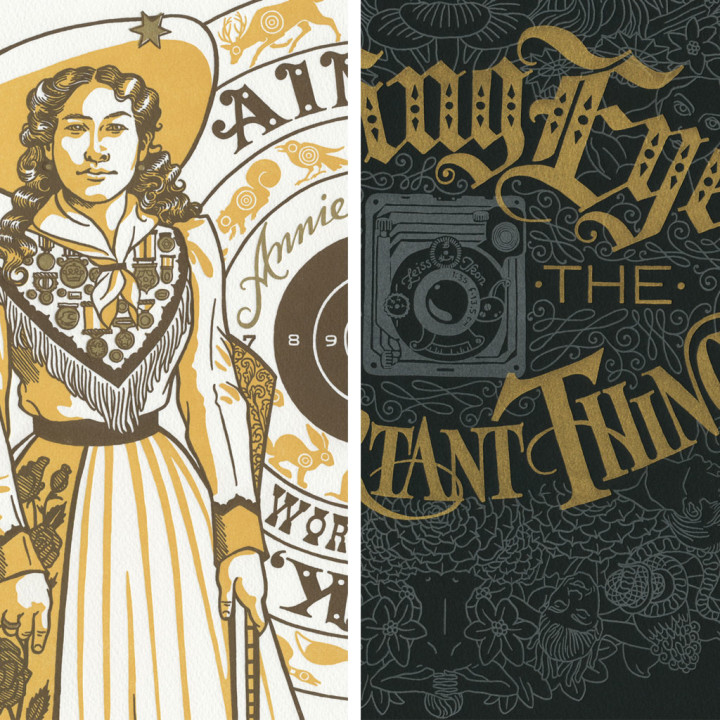
We’ve been in a flurry of holiday orders lately, and our Dead Feminist broadsides are flying off the shelf. I just did a count of our broadside inventory, and I thought I should tell you that both our Annie Oakley and Imogen Cunningham broadsides are nearly sold out. As of this writing (afternoon of Friday, December 18, 2015), we’re down to 7 copies of “Focal Point” and just 5 copies of “Gun Shy.” So if you’ve had your eye on either of these gals for awhile now, here’s your last shot! (And how often do I get to make a rifle pun and a camera pun at the same time?) You can bag them both, until they sell out, in our Dead Feminists shop.
June 26th, 2015
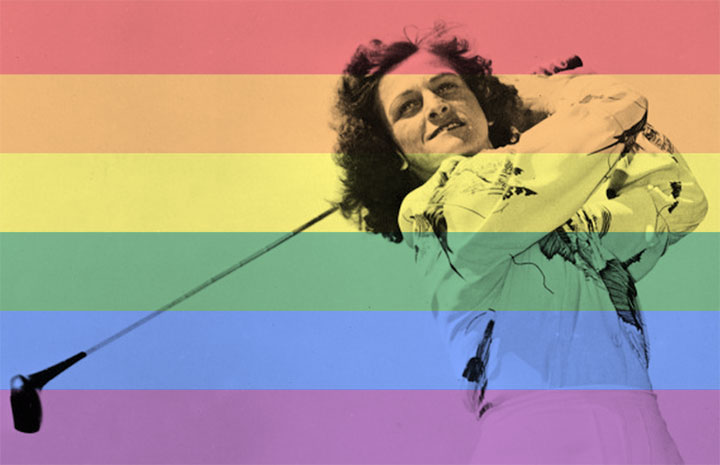
Babe Didrikson Zaharias and other LGBTQ public figures of her time didn’t have the option of living their lives they way they chose. But we think it’s a bit of poetic justice that the Supreme Court made their landmark decisions on all three LGBTQ cases (Obergefell v. Hodges in 2015, United States v. Windsor in 2013, and Lawrence v. Texas in 2003) on June 26: Babe’s birthday. So since today is also the start of Pride Weekend, we’re dedicating this weekend to Babe—happy birthday, happy Pride!
June 21st, 2015
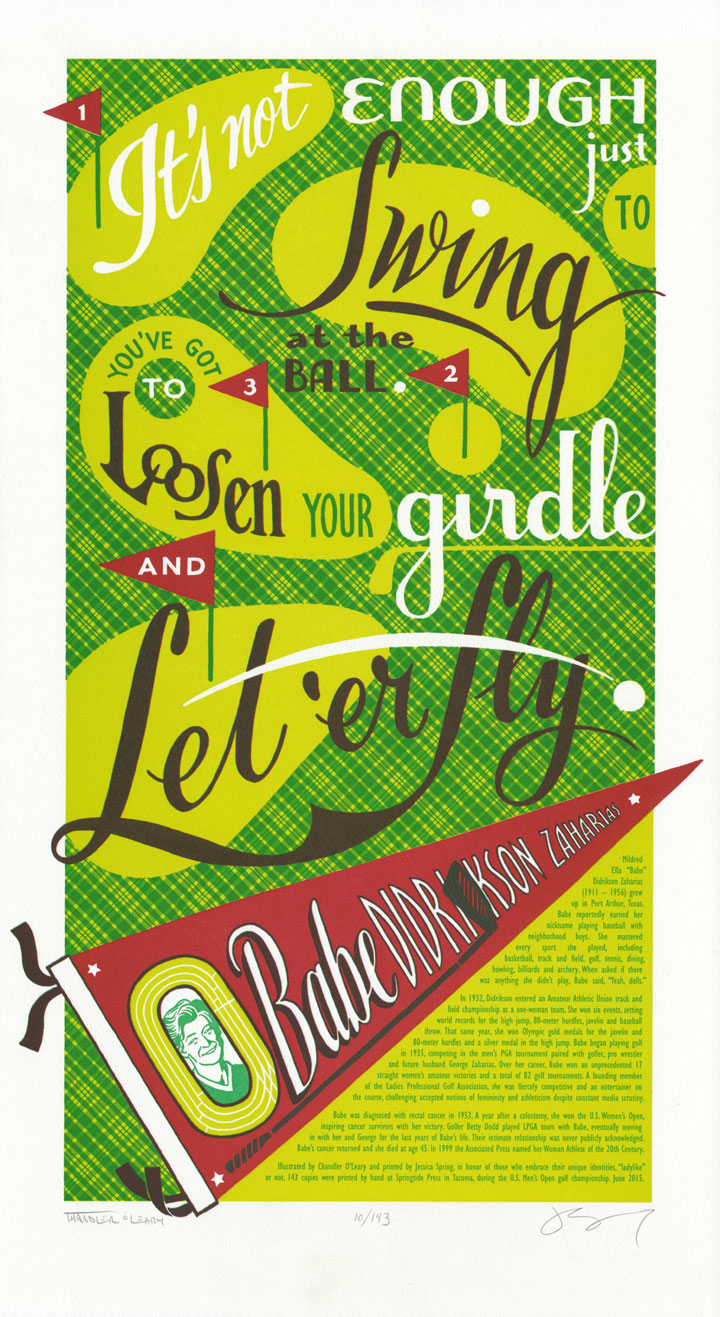
If you happen to be in the Pacific Northwest right now, you might find yourself surrounded by plus-fours and golf claps. This weekend marks the final days of the U.S. Open golf championship, which is being hosted in our hometown for the first time ever. The Chambers Bay golf course is one of the most beautiful and challenging in the world, and the U.S. Open attracts talented athletes and a ton of media attention. Yet all the coverage has reminded us of the need for a more level playing field for all athletes. So for our newest Dead Feminist broadside, we’ve unleashed the irrepressible showmanship of a golfer and all-star athlete who was a real contender (regardless of gender):
It’s not enough just to swing at the ball. You’ve got to loosen your girdle and let ‘er fly. — Babe Didrikson Zaharias

Babe is best-known for her prowess as a golfer. On the course she was more than a champion: she was a superstar. By 1950 she had won every golf title available to her, and she is still remembered for her 17 straight amateur women’s victories—a feat still unequaled by anyone. Even though her life and career were cut short by illness, she is still one of the most decorated golfers of all time.
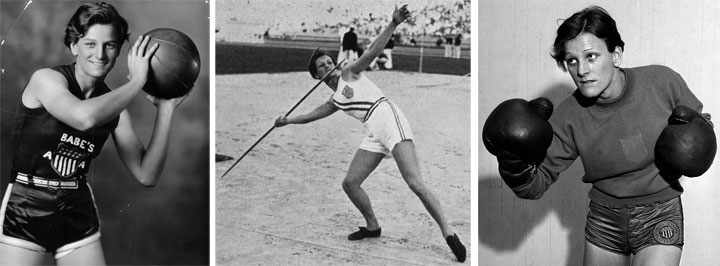
But Babe came late to golf—actually, she only switched focus entirely because she couldn’t maintain her amateur status as a golfer unless she gave up her other sports. Many have forgotten that she was also a champion at basketball, track and field, boxing, archery, tennis, diving, bowling, baseball and softball, roller skating and billiards—basically, a master at everything she tried. Babe was an all-star athlete in so many sports it’s hard to believe she was just one person. In fact, she demonstrated this fact by entering a 1932 amateur track and field championship as a one-women team. Babe qualified for three Olympic events (the maximum allowed at the time), but she actually finished first in five events and tied for first in a sixth, single-handedly racking up 30 team points. The second-place team? Well, they scored 22 points—with 22 members competing.
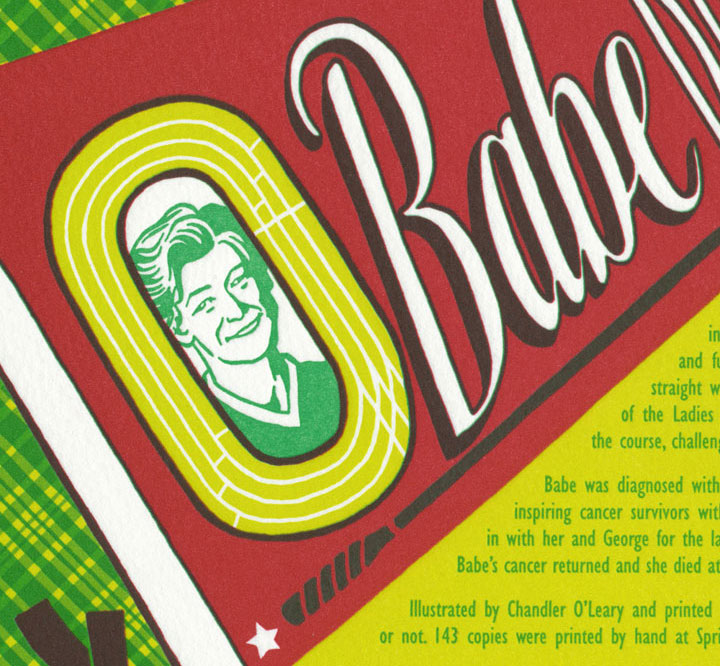
All of this is to illustrate how exceptional Babe was. People love to celebrate multi-event athletes like Michael Jordan or Deion Sanders for excelling at two sports, but how many of those guys were champions at half a dozen or more? Quite simply, Babe Didrikson Zaharias may just have been the greatest American athlete who ever lived. Period.
And this is where things get political. Just take a look at this list of the “Top 10 Greatest Multi-Sport Athletes“—Babe’s numbers blow every name on that list out of the water. (And she competed in many men’s events, as in her day there were often no women’s equivalents.) But Babe’s not on there. No women are. And that’s because even forty-plus years after Title IX, women athletes and women’s sports are of lesser value than their male counterparts. In fact, the words women’s and ladies’ are used as qualifiers, to denote an exception to the default. When you hear the name of a sporting event, and no gender is named, the assumption is that it’s a men’s event. (Heck, I’ve been hearing it all week in the golf coverage: it’s the “U.S. Open” and the “U.S. Women’s Open”—no mention of a “U.S. Men’s Open.”) When an athlete is recognized for her achievements, she is mentioned only on all-women lists. Some sports, like baseball and American football, have no “official” women’s equivalent—while others have different rules for the women’s version, like the arbitrary ban on body checking in women’s ice hockey. Women’s sports make a fraction of what men’s sports make in ticket sales and merchandising revenue. Men’s events still dominate the mainstream coverage air time on television, radio and news. And “you throw like a girl” is still an insult heard every day in America. We’re not advocating for co-ed sports here; we fully understand the practical rationale behind sex-segregation in athletics. But the differing value and respect our culture places on each is another matter entirely. Even the money male and female athletes win and earn is vastly disparate; take the U.S. Open, for example. The winner’s purse in the men’s tournament: $10 million. In the women’s tournament? Less than half, at $4 million. Apparently golf is played on a grass course with a glass ceiling.
In Babe’s lifetime, she was not only hampered by a host of restrictions on women competitors, she was also plagued by a media that ignored her accomplishments and focused instead on her tomboyish looks, brash demeanor and (lack of) relationship status. The pressure was relentless: the New York World-Telegram wrote, “It would be much better if she and her ilk stayed at home, got themselves prettied up and waited for the phone to ring.” Even Babe, known for her arrogant show-boating and fiercely competitive nature, started wearing lipstick and more feminine clothing, stating, “I know I’m not pretty, but I try to be graceful.” Many have even argued that she switched to golf and married George Zaharias simply to conform to societal pressures to look and act more ladylike. She certainly treated these changes as a media makeover—perhaps to get the press off her back and shift the focus back to her abilities. So Jessica and I can’t help but wonder how her career might have been different if “pretty” weren’t a factor—if she could have been recognized and remembered for who she was, rather than what she wasn’t.

Since Babe was a marvel whose skill transcended all gender divisions, we wanted to make our broadside design as gender-neutral as possible. Instead, we focused on the game itself. Our 22nd broadside, Title Nine Iron, is a tribute to Babe’s best sport (with a nod to her beginnings as a track star), decked out in golf plaids and bright fairways. Follow the flags around the course with Babe’s quote, and let her words lift you over the rough and onto the green. And to keep our visual puns on par with our message of athletic equality, Babe’s bright red pennant is bedecked with a symbolic “Title IX” club: a nine iron.
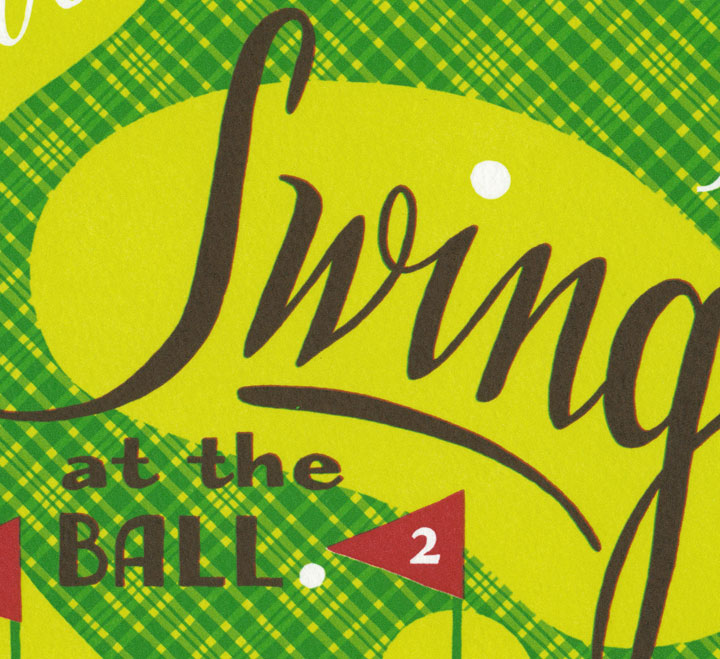
Babe struggled throughout her career for recognition in the face of gender discrimination. Unfortunately, women athletes still face this sort of battle today—which makes legislation like Title IX incredibly important, even all these years later. So to help give girls everywhere equal access to sports and athletic training, we are donating a portion of our proceeds to the Women’s Sports Foundation. Founded in 1974 by tennis legend Billie Jean King, the Women’s Sports Foundation works to advance the lives of girls and women through physical activity.
• • • • • • • • • • • • • • • • • • • • • • • • • • • • • • • • • • • • • • • • • • • • • • • • • • • • • • • • • • • •
Title Nine Iron: No. 22 in the Dead Feminists series
Edition size: 143 prints
Poster size: 10 x 18 inches
Printed on an antique Vandercook Universal One press, on archival, 100% rag (cotton) paper. Each piece is numbered and signed by both artists.
Colophon reads:
Mildred Ella “Babe” Didrikson Zaharias (1911 – 1956) grew up in Port Arthur, Texas. Babe reportedly earned her nickname playing baseball with neighborhood boys. She mastered every sport she played, including basketball, track and field, golf, tennis, diving, bowling, billiards and archery. When asked if there was anything she didn’t play, Babe said, “Yeah, dolls.”
In 1932, Didrickson entered an Amateur Athletic Union track and field championship as a one-woman team. She won six events, setting world records for the high jump, 80-meter hurdles, javelin and baseball throw. That same year, she won Olympic gold medals for the javelin and 80-meter hurdles and a silver medal in the high jump. Babe began playing golf in 1935, competing in the men’s PGA tournament paired with golfer, pro wrestler and future husband George Zaharias. Over her career, Babe won an unprecedented 17 straight women’s amateur victories and a total of 82 golf tournaments. A founding member of the Ladies Professional Golf Association, she was fiercely competitive and an entertainer on the course, challenging accepted notions of femininity and athleticism despite constant media scrutiny.
Babe was diagnosed with rectal cancer in 1953. A year after a colostomy, she won the U.S. Women’s Open, inspiring cancer survivors with her victory. Golfer Betty Dodd played LPGA tours with Babe, eventually moving in with her and George for the last years of Babe’s life. Their intimate relationship was never publicly acknowledged. Babe’s cancer returned and she died at age 45. In 1999 the Associated Press named her Woman Athlete of the 20th Century.
Illustrated by Chandler O’Leary and printed by Jessica Spring, in honor of those who embrace their unique identities, “ladylike” or not. Printed by hand in Tacoma during the U.S. Men’s Open golf championship.
Now available in our Dead Feminists web shop!
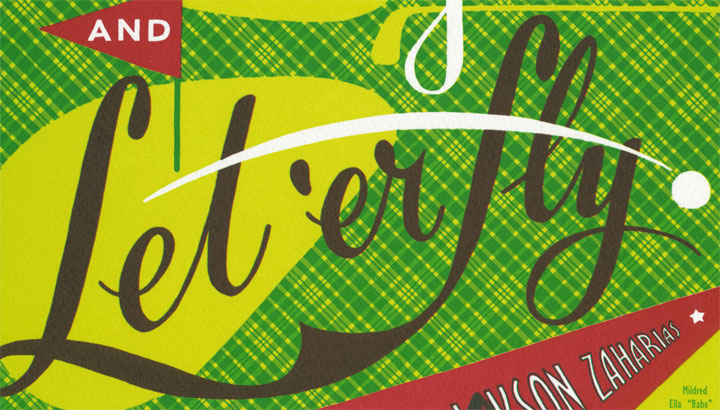
June 11th, 2015
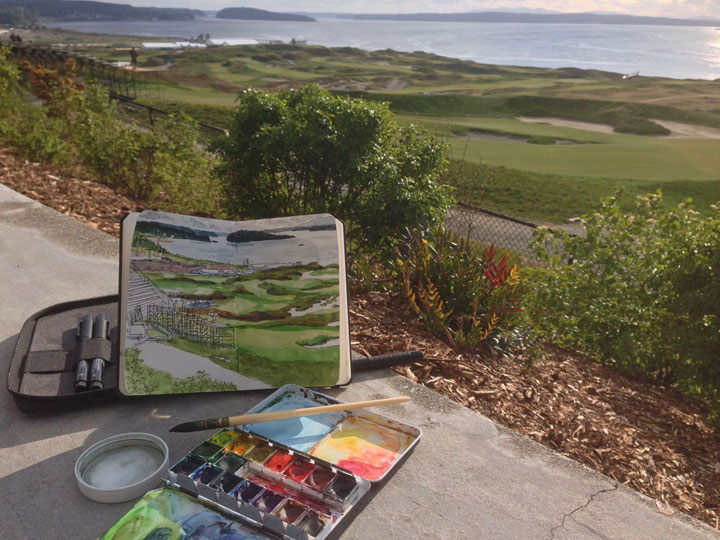
There’s a very big sporting event coming to my town next week—and even though I’m not a ticketholder (or even all that interested in the sport itself), the spectacle is already proving to be a big source of inspiration.
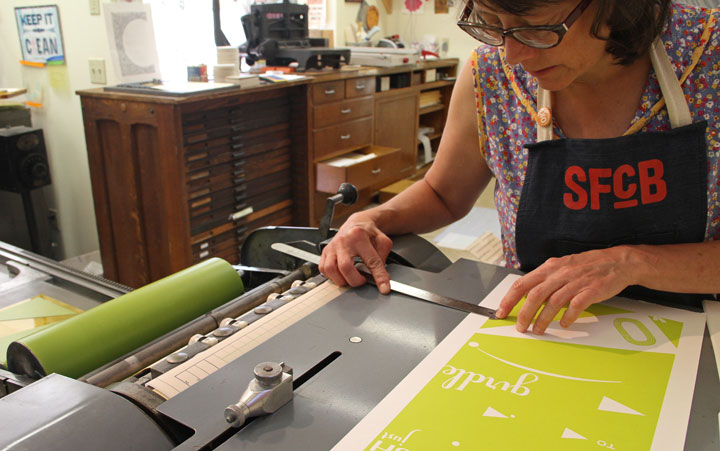
So here’s another piece of what Jessica and I are working on—look for more next week!
June 7th, 2015
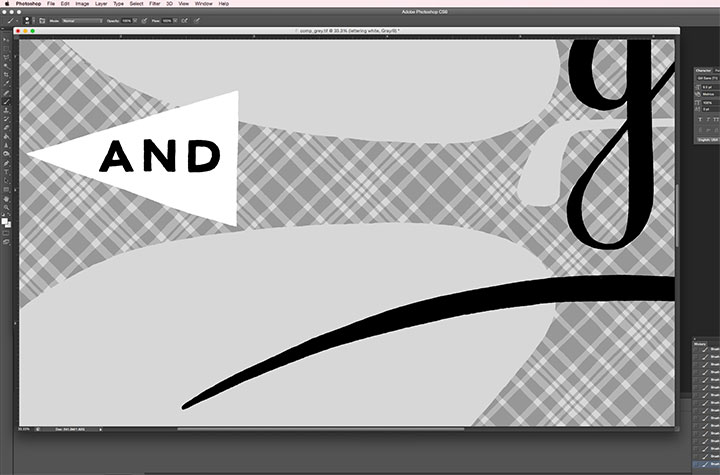
Amidst all the Kickstarter hubbub, I have another deadline to attend to: Jessica and I are releasing a new Dead Feminist broadside in a week or so. Normally I would have postponed that for a bit, at least until the Kickstarter was behind me, but we’re timing the new broadside to align with a big event. So, yeah. It’s not ideal, but the timing is out of our hands for this one.
Anyway, I thought I’d show you a snippet of what we’re working on. No, the broadside won’t be in black-and-white, but every design goes through a black-and-white phase before it goes on press in living color. It’s actually a good thing to do, even if it weren’t necessary to the production process: viewing a design in shades of grey is a lot like showing it to a pair of fresh eyes. Without color to distract me, I can look at the design objectively and make one last call to make sure it’s working as a whole. And besides, the color separations for the new piece are really, really complicated (as you’ll soon see). I’ve spent two days staring at this greyscale version of the design in Photoshop, checking and rechecking that I did it right and all the layers line up correctly. I don’t want Jessica to be in for any nasty surprises when this thing goes on press tomorrow.
Wish us luck! More soon.
May 14th, 2015

Jessica and I are working on the next Dead Feminist broadside right now—our process begins with choosing a quote and hammering out a rough concept, and then I do a bunch of thumbnail sketches to puzzle out the design. Usually, by the time I start lettering in pencil, I have a really clear picture in my head of what the finished product should look like. Even so—even 22 broadsides later—I’m still intimidated by the proverbial blank page. That’s why all those thumbnail sketches come in handy: they help illuminate the next step, and the next, and the next. And if I’m really lucky, I’ll be so wrapped up in blocking out the composition that I’ll forget to worry about whether or not the design will be any good.
Fingers crossed…time to start in.
May 5th, 2015
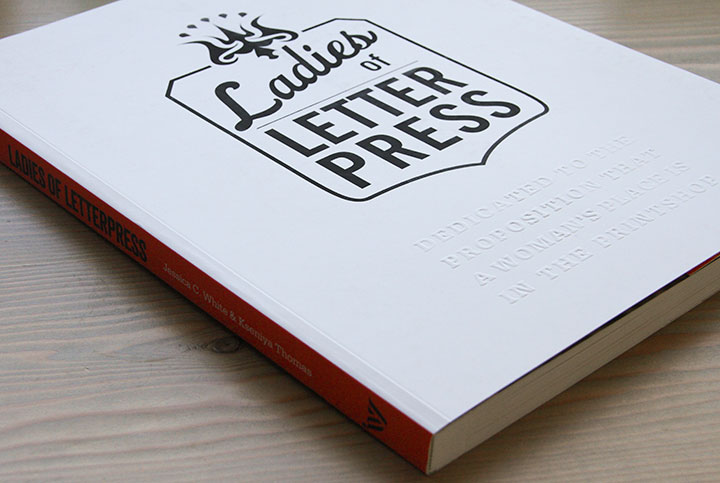
This beauty arrived in the post a little while ago, and I finally remembered to put it down for a moment to take some photos to share with you. Our Dead Feminists are in a new book! Our friends Kseniya Thomas and Jessica C. White, who founded the Ladies of Letterpress organization and conference, have just published a gorgeous anthology of women printers with the Ivy Press and Princeton Architectural Press.
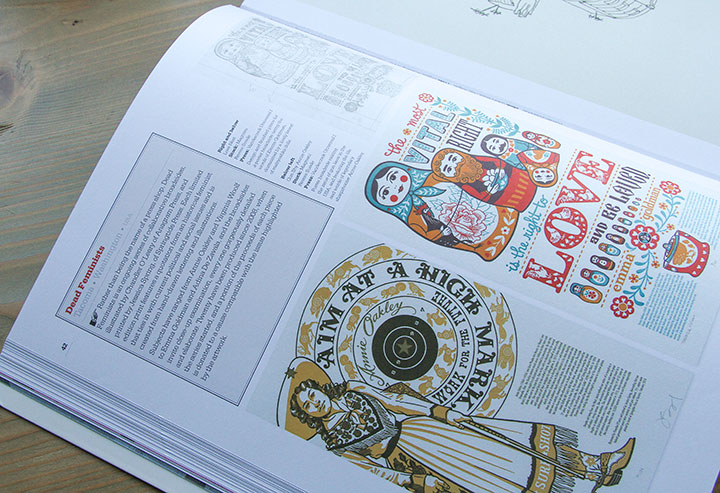
The format of the book is really something special. First of all, it’s huge—a whopping 11 x 14 inches—so you can really get in close and see the detail of all the work featured. Second, each page features a large piece on one side, and smaller images and background info on the other—and every page is perforated, so those who want to can turn their favorite pages into frameable wall art. (Not that this book purist would do that, but it’s a great idea!)
Jessica and I are honored to be a part of the book, and proud to be some of the earliest members of the Ladies of Letterpress community. Best of all, it feels so good to be in a book with so many of our friends and colleagues, and included with such great work being done around the U.S. So in honor of our community of printer friends, we’ve been given the green light to share our contributor’s discount with all our friends. If you’d like a copy of the book, you can order it at PA Press and enter the code LETTER for a 35% discount!
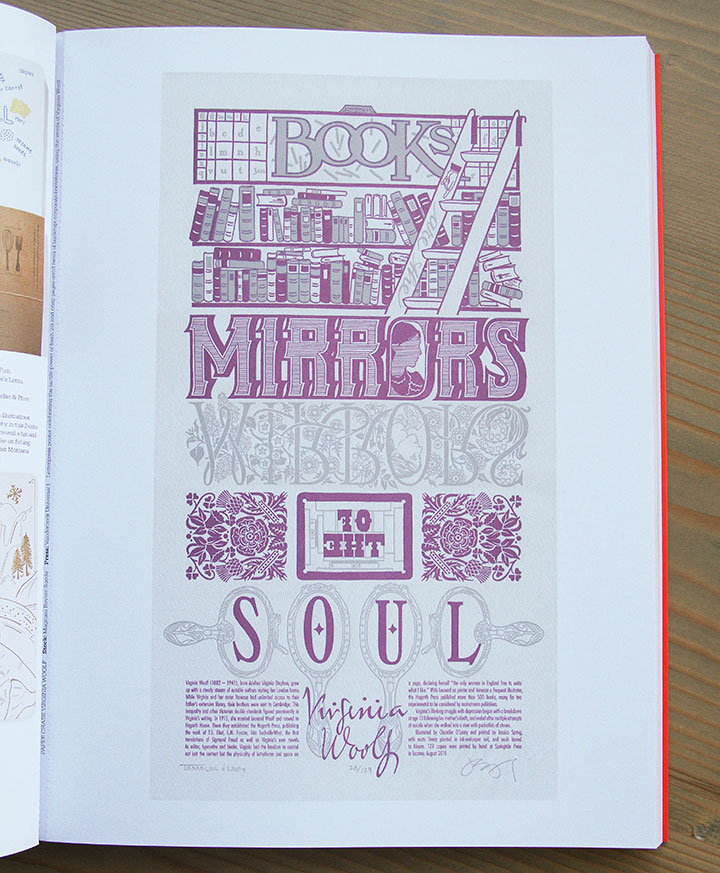
And speaking of community and the Dead Feminists, Jessica and I have a large batch of them on display right now at the gallery at the Minnesota Center for Book Arts. (I don’t have a photo of the show yet to share with you, but when I get one I’ll post it here.) The exhibit is called The Contained Narrative, and deals with all the myriad ways books and broadsides tell a story—from the traditional to the unexpected. Nine of our broadsides will be on display (it’s been many years since we displayed so many at once!), as part of the “Book as Community & Collaboration” section of the show.
The exhibit is already on display, and timed to run through the 2015 Book Arts Biennial this summer—where book artists and visitors from around the world will see it. If you happen to be in the Twin Cities this season, here are the details:
The Contained Narrative: Defining the Contemporary Artist Book
April 8 through July 26, 2015
Star Tribune Foundation Gallery, Minnesota Center for Book Arts
1011 Washington Avenue South, Minneapolis, MN
Opening reception: Friday, May 8, 6 to 9 pm
Closing reception: Friday, July 24, 6 to 9 pm
More info and list of artists here
March 15th, 2015

One of the highlights of my recent trip was finally getting to see an illustration subject in person. Back when Jessica and I created our On a Mission Dead Feminist broadside a few years ago, we did a ton of research about San Antonio and the Alamo—but neither of us had ever actually been there in person. So you can imagine how much I geeked out when I visited the place—especially when I saw a plaque explaining how our girl Adina De Zavala is responsible for saving and preserving the place.
Here’s hoping there are many more Dead Feminist field trips in the future!
February 20th, 2015
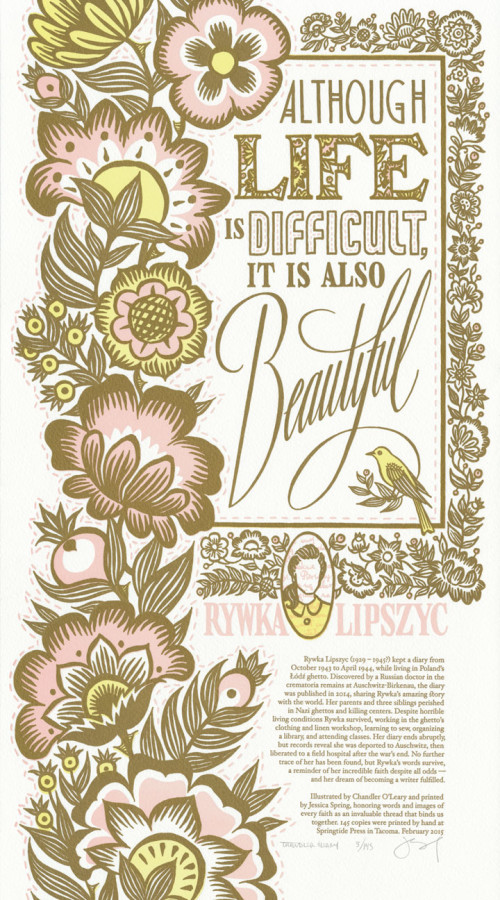
For our last broadside, we focused on a woman from the Islamic world; now we’re back with an homage to Judaica. The juxtaposition of the two pieces was no accident on our part. Yet the timing of world events was something we could never have planned. We originally meant to tie our new piece in with the 70th anniversary of the liberation of Auschwitz—last month, the anti-Semitic terrorist attacks in Paris gave us a terrible new perspective for our piece.
What really bowled us over is that the young woman we chose to highlight for the new piece underscores the relationship between the two events, the two time periods in history. You see, our gal is a historical figure, yet the world has only just discovered her. So here we present to you the words of a young writer, whose diary, along with her faith, carried her through one of the darkest times in human history:
Although life is difficult, it is also beautiful. — Rywka Lipszyc (pronounced “Rivka Lipschitz”)
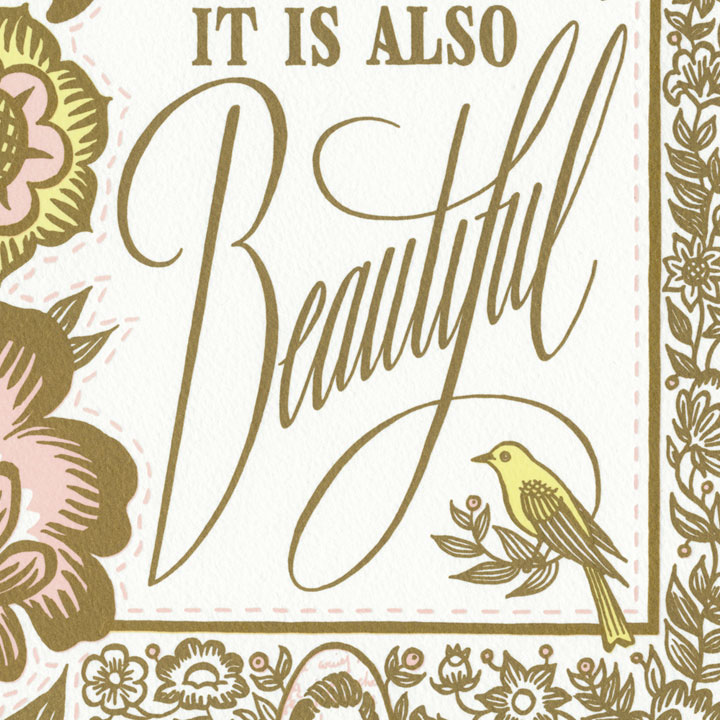
Rywka’s story is astonishing, if only for the fact that it can be told at all. Rywka was a teenager living in one of the worst Jewish ghettos of Nazi-occupied Poland during World War II. By the time she started her diary at age fourteen, she had already lost all but one of her family members. While working as a factory seamstress and caring for her younger sister, she poured her heart and faith into the pages of her notebook. At times the diary is a harrowing account of wartime hardship; at others, it reads like the missives of any normal, modern teenage girl. The pages are dense but not numerous: just a few months after it begins, the diary ends abruptly—and with it most of our knowledge of Rywka’s life. We know she was deported to Auschwitz a few months later; and that her sister was murdered upon arrival at the camp. We know she was liberated from Auschwitz by allied troops 70 years ago—but then her trail goes cold, like that of so many other victims of the Holocaust. Historians are sure she did not survive for long after the liberation, but that’s all they’re sure of: no further details of Rywka’s fate have been uncovered. No photo of her exists, nor any other trace of her life beyond the diary, a few registration records, and the memories of a trio of surviving cousins living in Israel.
What is truly remarkable is that the diary survived the war, the camps and the intervening decades. A Russian army doctor allegedly found the diary in the ashes of the Auschwitz crematorium. The doctor made a few notes in the margins, and then put it away in her closet at home—for the rest of her life. Upon her death, her son found the diary, and then he stashed it away for several more decades. When he died, his daughter—the granddaughter of the army doctor—traveled back to Russia from the U.S., and found the diary among his effects. This time, however, she knew just what to do with it. She took it back with her to the States, and turned it over to the JFCS Holocaust Center in San Francisco. They then authenticated and translated the diary—and published it in book form less than a year ago.
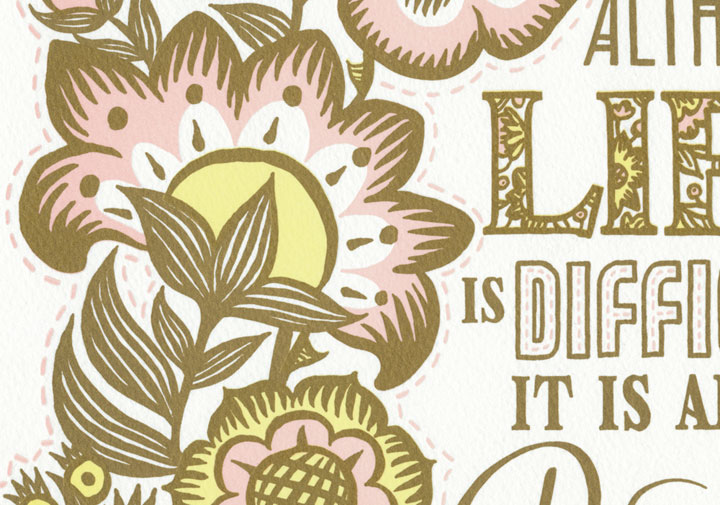
Jessica and I were able to get a hold of the new publication at the Pacific Lutheran University library (many thanks to Holly Senn for tracking the book down for us!). In reading the text, we were struck by Rywka’s use of metaphor—particularly her mentions of flowers growing among thorns. So we took Rywka’s imagery and wove the broadside’s design and theme around it.
Common Threads is a winter garden of pale pastels and subtle metallic golds. The delicate colors and shining metallic ink (which includes real gold in the formula) represent the fragility and preciousness of life among the thorns of war and persecution. The floral motif echoes themes from Rywka’s diary, and stands for the resilience of the Jewish people—whose culture has flourished beautifully despite some of the worst trials endured by humankind.
The overall design of the broadside is based on Rywka’s dual cultural heritage. The border is reminiscent of Jewish embroidered challah covers and sabbath cloths, while the style of floral illustration is derived from Polish folk florals. The stitched lines are a nod to Rywka’s trade as seamstress, which she viewed optimistically as a way to move forward and make a living in a future beyond wartime.
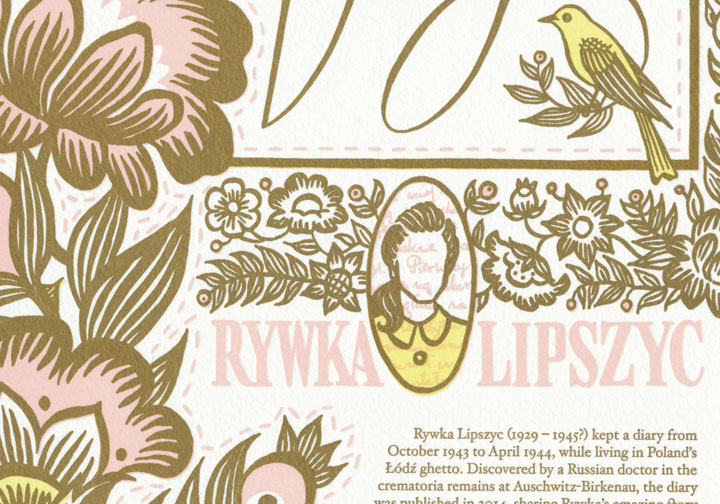
To help fight anti-Semitism worldwide and defend civil rights for all, we are donating a portion of our proceeds to the Anti-Defamation League — one of the nation’s top human and civil rights organizations for over 100 years.
• • • • • • • • • • • • • • • • • • • • • • • • • • • • • • • • • • • • • • • • • • • • • • • • • • • • • • • • • • • •
Common Threads: No. 21 in the Dead Feminists series
Edition size: 145 prints
Poster size: 10 x 18 inches
Printed on an antique Vandercook Universal One press, on archival, 100% rag (cotton) paper. Each piece is numbered and signed by both artists.
Colophon reads:
Rywka Lipszyc (1929 – 1945?) kept a diary from October 1943 to April 1944, while living in Poland’s Łódź ghetto. Discovered by a Russian doctor in the crematoria remains at Auschwitz-Birkenau, the diary was published in 2014, sharing Rywka’s amazing story with the world. Her parents and three siblings perished in Nazi ghettos and killing centers. Despite horrible living conditions Rywka survived, working in the ghetto’s clothing and linen workshop, learning to sew, organizing a library, and attending classes. Her diary ends abruptly, but records reveal she was deported to Auschwitz, then liberated to a field hospital after the war’s end. No further trace of her has been found, but Rywka’s words survive, a reminder of her incredible faith despite all odds — and her dream of becoming a writer fulfilled.
Illustrated by Chandler O’Leary and printed by Jessica Spring, honoring words and images of every faith as an invaluable thread that binds us together.
Now available in our new web shop!
• • • • • • • • • • • • • • • • • • • • • • • • • • • • • • • • • • • • • • • • • • • • • • • • • • • • • • • • • • • •
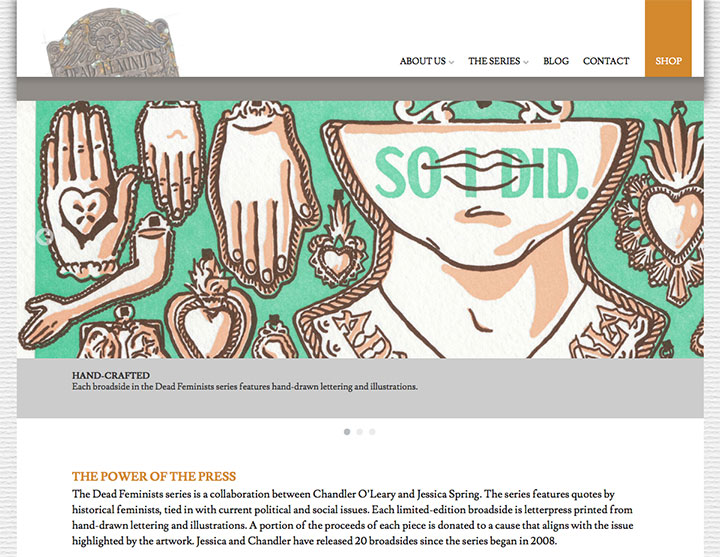
Speaking of which, we finally have a website dedicated to the Dead Feminists series. It has been years in the making, and while we haven’t quite worked out all the kinks yet (bear with us on that), we’re thrilled to be up and running at last. Many thanks to our amazing web designers, Elizabeth Anderson and Paul Ferguson, for making it all happen!
On the new site you’ll find the stories behind each broadside in the series, glimpses into our process, information about our live events, and of course the new web shop (which contains all our broadsides and postcards). So head on over and take a gander!
February 11th, 2015
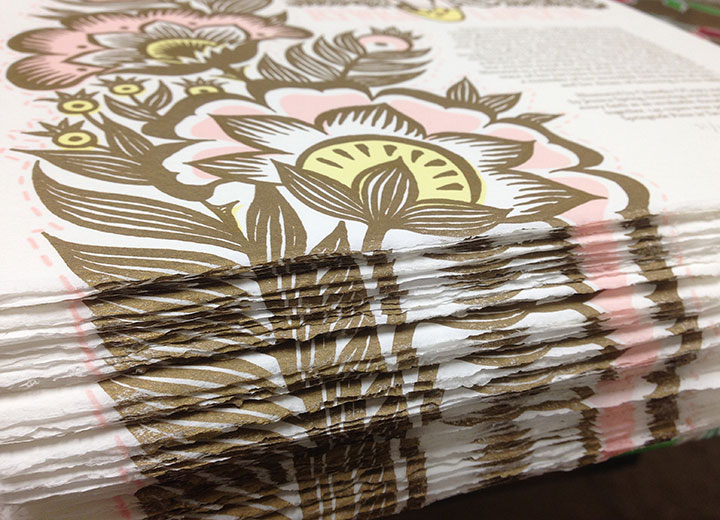
Today is the last day of CODEX, and since people there have been able to see this thing already, Jessica and I thought we should give you a glimpse as well. Look for the new Dead Feminist broadside to appear online at the end of next week!

![Chandler O'Leary [logo]](https://chandleroleary.com/wp-content/themes/chandleroleary/images/logo.png)





















